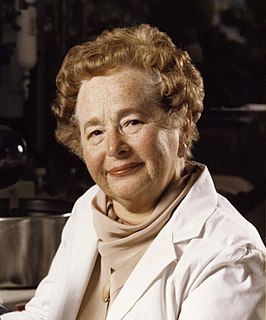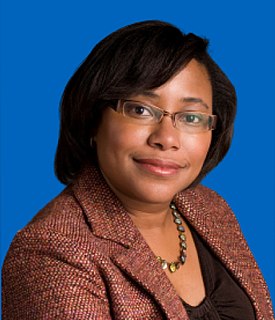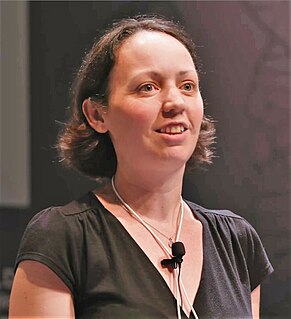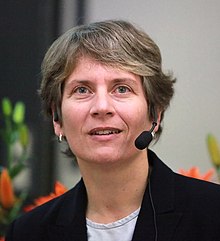
Gertrude "Trudy"Belle Elion was an American biochemist and pharmacologist, who shared the 1988 Nobel Prize in Physiology or Medicine with George H. Hitchings and Sir James Black for their use of innovative methods of rational drug design for the development of new drugs. This new method focused on understanding the target of the drug rather than simply using trial-and-error. Her work led to the creation of the anti-retroviral drug AZT, which was the first drug widely used against AIDS. Her well known works also include the development of the first immunosuppressive drug, azathioprine, used to fight rejection in organ transplants, and the first successful antiviral drug, acyclovir (ACV), used in the treatment of herpes infection.

Robert Samuel Langer, Jr. FREng is an American chemical engineer, scientist, entrepreneur, inventor and one of the twelve Institute Professors at the Massachusetts Institute of Technology.

Roger Yonchien Tsien was an American biochemist. He was a professor of chemistry and biochemistry at the University of California, San Diego and was awarded the Nobel Prize in Chemistry for his discovery and development of the green fluorescent protein, in collaboration with organic chemist Osamu Shimomura and neurobiologist Martin Chalfie. Tsien was also a pioneer of calcium imaging.

Lara K. Mahal is the Canada Excellence Research Chair in Glycomics at the University of Alberta in Edmonton, Alberta, Canada. She is also a Professor of Chemistry at the University of Alberta. She is notable both for her pioneering work establishing lectin microarrays as a new technology for glycomics, her work on miRNA regulation of glycosylation and her graduate work with Carolyn R. Bertozzi on unnatural carbohydrate incorporation. Work in her laboratory focuses on understanding the role of carbohydrates in human health using systems- and chemical biology-based approaches

JoAnne Stubbe is an American chemist best known for her work on ribonucleotide reductases, for which she was awarded the National Medal of Science in 2009. In 2017, she retired as a Professor of Chemistry and Biology at the Massachusetts Institute of Technology.
Xiaowei Zhuang is a Chinese-American biophysicist who is the David B. Arnold Jr. Professor of Science, Professor of Chemistry and Chemical Biology, and Professor of Physics at Harvard University, and an Investigator at the Howard Hughes Medical Institute. She is best known for her work in the development of Stochastic Optical Reconstruction Microscopy (STORM), a super-resolution fluorescence microscopy method, and the discoveries of novel cellular structures using STORM. She received a 2019 Breakthrough Prize in Life Sciences for developing super-resolution imaging techniques that get past the diffraction limits of traditional light microscopes, allowing scientists to visualize small structures within living cells. She was elected a Member of the American Philosophical Society in 2019 and was awarded a Vilcek Foundation Prize in Biomedical Science in 2020.
Laura Lee Kiessling is an American chemist and the Novartis Professor of Chemistry at the Massachusetts Institute of Technology. Kiessling's research focuses on elucidating and exploiting interactions on the cell surface, especially those mediated by proteins binding to carbohydrates. Multivalent protein-carbohydrate interactions play roles in cell-cell recognition and signal transduction. Understanding and manipulating these interactions provides tools to study biological processes and design therapeutic treatments. Kiessling's interdisciplinary research combines organic synthesis, polymer chemistry, structural biology, and molecular and cell biology.
Alanna Schepartz is an American professor and scientist. She is currently the T.Z. and Irmgard Chu Distinguished Chair in Chemistry at University of California, Berkeley. She was formerly the Sterling Professor of Chemistry at Yale University.
The term bioorthogonal chemistry refers to any chemical reaction that can occur inside of living systems without interfering with native biochemical processes. The term was coined by Carolyn R. Bertozzi in 2003. Since its introduction, the concept of the bioorthogonal reaction has enabled the study of biomolecules such as glycans, proteins, and lipids in real time in living systems without cellular toxicity. A number of chemical ligation strategies have been developed that fulfill the requirements of bioorthogonality, including the 1,3-dipolar cycloaddition between azides and cyclooctynes, between nitrones and cyclooctynes, oxime/hydrazone formation from aldehydes and ketones, the tetrazine ligation, the isocyanide-based click reaction, and most recently, the quadricyclane ligation.

Jennifer Anne Doudna is an American biochemist who has done pioneering work in CRISPR gene editing, and made other fundamental contributions in biochemistry and genetics. She received the 2020 Nobel Prize in Chemistry, with Emmanuelle Charpentier, "for the development of a method for genome editing." She is the Li Ka Shing Chancellor's Chair Professor in the Department of Chemistry and the Department of Molecular and Cell Biology at the University of California, Berkeley. She has been an investigator with the Howard Hughes Medical Institute since 1997.

Erin K. O'Shea Ph.D. is President of the Howard Hughes Medical Institute (HHMI). In 2013, she was named HHMI's Vice President and Chief Scientific Officer. Prior to that, she was a Professor of Molecular and Cellular Biology and Chemistry and Chemical Biology at Harvard University. In 2016, her appointment as future, and first woman, President of HHMI was announced. She has been a Howard Hughes Medical Institute (HHMI) investigator since 2000.
Zhenan Bao, is the K. K. Lee Professor of Chemical Engineering at Stanford University, with courtesy appointments in Chemistry and Material Science and Engineering. She has served as the Department Chair of Chemical Engineering from 2018-2022. She is known for her work on organic field-effect transistors and organic semiconductors, for applications including flexible electronics and electronic skin.

Paula Therese Hammond is a David H. Koch Professor in Engineering and the Head of the Department of Chemical Engineering at the Massachusetts Institute of Technology (MIT). She was the first woman and person of color appointed as head of the Chemical Engineering department. Her laboratory designs polymers and nanoparticles for drug delivery and energy-related applications including batteries and fuel cells.

Judith P. Klinman is an American chemist, biochemist, and molecular biologist known for her work on enzyme catalysis. She became the first female professor in the physical sciences at the University of California, Berkeley in 1978, where she is now Professor of the Graduate School and Chancellor's Professor. In 2012, she was awarded the National Medal of Science by President Barack Obama. She is a member of the National Academy of Sciences, American Academy of Arts and Sciences, American Association for the Advancement of Science, and the American Philosophical Society.
Ramesh Jasti is a professor of organic chemistry at the University of Oregon. He was the first person to synthesize the elusive cycloparaphenylene in 2008 during post doctoral work in the laboratory of Professor Carolyn Bertozzi. He started his laboratory at Boston University where he was the recipient of the NSF CAREER award. His early lab repeatedly broke the record for the synthesis of the smallest cycloparaphenylene known. In 2014, he moved his laboratory to the University of Oregon where he expanded his focus to apply the molecules he discovered in the areas of organic materials, mechanically interlocked molecules, and biology. He is the Associate Director of the Materials Science Institute at the University of Oregon.
Mireille Kamariza is a Burundian-born American bioscientist and Harvard Junior Fellow. Her research considers infectious diseases, the development of low cost point-of-care diagnostics and global health. In 2020 she was named as one of Chemical & Engineering News's Talented 12.

Celeste M. Nelson is a Professor of Chemical and Biological Engineering and the Director of the Program in Engineering Biology at Princeton University. She is a Fellow of the American Institute for Medical and Biological Engineering (AIMBE) and was a finalist in the 2017 and 2018 Blavatnik Awards for Young Scientists.
Jessica R. Kramer is an American biomedical engineer working as an Assistant Professor of Bio-engineering and Adjunct Assistant Professor of Pharmaceutics and Pharmaceutical Chemistry at the University of Utah. Kramer’s research lab focuses on the synthesis and application of glycopolypeptides.
Ellen Sletten is an American chemist who is the John McTague Career Development Chair at University of California, Los Angeles. Her research considers the use of physical organic chemistry for diagnostics and medical therapies.
Jennifer Ann Prescher is an American chemist who is a professor of chemistry at the University of California, Irvine. Her research considers the development of bioorthogonal, bioluminescent tools for the noninvasive, real-time imaging of immunometabolism.












